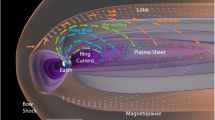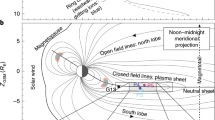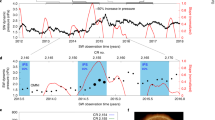Abstract
TRANSITS of some interplanetary magnetic sector boundaries across the Earth were shown by Svestka et al.1 to be followed by streams of protons with energies in the range of a few MeV. These proton boundary transits were associated with a characteristic decrease2–4 of the vorticity area index (VAI) during Northern Hemisphere winter that was about twice as large as the decrease associated with all the other boundary transits during the same interval. I show here that the MeV proton streams associated by Svestka et al.1 with certain sector boundary transits apparently select boundary transits associated with unusually active conditions in the solar wind. These proton boundary transits were associated with a larger change in tropospheric circulation than were the other boundary transits observed during the same interval of time. New information in the present study of sector boundary transits relating changes in solar wind velocity, density and magnetic field to the resulting terrestrial changes in vorticity area index, geomagnetic activity and cosmic ray flux at Earth may provide a test for proposed physical mechanisms.
This is a preview of subscription content, access via your institution
Access options
Subscribe to this journal
Receive 51 print issues and online access
$199.00 per year
only $3.90 per issue
Buy this article
- Purchase on Springer Link
- Instant access to full article PDF
Prices may be subject to local taxes which are calculated during checkout
Similar content being viewed by others
References
Svestka, Z., Fritzova-Svestkova, L., Nolte, J. T., Dodson-Prince, H. W. & Hedeman, E. R. Solar Phys. 50, 491–500 (1976).
Wilcox, J. M., Scherrer, P. H., Svalgaard, L., Roberts, W. O. & Olson, R. H. Science 180, 185–186 (1973).
Wilcox, J. M. et al. J. atmos. Sci. 31, 581–588 (1974).
Wilcox, J. M., Svalgaard, L. & Scherrer, P. H. J. atmos. Sci. 33, 1113–1116 (1976).
Svalgaard, L. Stanford Univ. Inst. Plasma Res. Rep. No 629, (1975).
Svalgaard, L. Stanford Univ. Inst. Plasma Res. Rep. No 648 (1976).
Roberts, W. O. & Olson, R. H. Revs. Geophys. Space Phys. 11, 731–740 (1973).
Mayaud, P. N. J. geophys. Res. 77, 6870 (1972).
Svalgaard, L. in Coronal Holes and Solar Wind Streams (ed Zirker, J.) Ch. IX (University of Colorado Assoc. Press, 1977).
Marshall, F. E. & Stone, E. C. J. geophys. Res. 83, 3289–3298 (1978).
Olson, R. H., Roberts, W. O. & Zerofos, C. S. Nature 257, 113–115 (1975).
Olson, R. H., Roberts, W. O., Dodson-Prince, H. & Hedeman, E. R. Nature 274, 140–142 (1978).
Wilcox, J. M. Space Sci. Rev. 8, 258–328 (1968).
Author information
Authors and Affiliations
Rights and permissions
About this article
Cite this article
WILCOX, J. Tropospheric circulation and interplanetary magnetic sector boundaries followed by MeV proton streams. Nature 278, 840–841 (1979). https://doi.org/10.1038/278840a0
Received:
Accepted:
Issue Date:
DOI: https://doi.org/10.1038/278840a0
This article is cited by
-
Applying machine learning in the investigation of the link between the high-velocity streams of charged solar particles and precipitation-induced floods
Environmental Monitoring and Assessment (2024)
-
A possible relation between geomagnetic activity and winter air surface temperatures in Prague
Studia Geophysica et Geodaetica (1992)
-
The IMF sector structure effects in total ozone in central Europe
Studia Geophysica et Geodaetica (1989)
-
North-south asymmetry in response of geomagnetic activity to different solar events
Journal of Earth System Science (1987)
-
Effects of the interplanetary magnetic field sector structure in the winter ionosphere
Studia Geophysica et Geodaetica (1986)
Comments
By submitting a comment you agree to abide by our Terms and Community Guidelines. If you find something abusive or that does not comply with our terms or guidelines please flag it as inappropriate.



